by Claire Davis | Nov 3, 2022
 With the holiday season fast approaching, everyone’s favorite dishes will soon appear on the dinner table. Everyone has different taste buds, so that means everyone has different favorite dishes. I know that I am looking forward to sweet potato soufflé and deviled eggs, but I could definitely do without the cranberry sauce. Unfortunately, many parents find themselves in a bind trying to feed their picky eaters. Remember, you are not alone in this battle, and try not to get too frustrated by this typical behavior. This article includes some tips on what to avoid and strategies to help your favorite picky eater!
With the holiday season fast approaching, everyone’s favorite dishes will soon appear on the dinner table. Everyone has different taste buds, so that means everyone has different favorite dishes. I know that I am looking forward to sweet potato soufflé and deviled eggs, but I could definitely do without the cranberry sauce. Unfortunately, many parents find themselves in a bind trying to feed their picky eaters. Remember, you are not alone in this battle, and try not to get too frustrated by this typical behavior. This article includes some tips on what to avoid and strategies to help your favorite picky eater!
DO:
Eat family style. Trying sharing a meal together, as a whole family, as often as you can. This means sitting at a table and turning off the distractions like TV, radio, or cell phones at mealtime. When preparing for your family’s well-balanced meal, incorporate at least one food you know that your picky eater likes. Eating family style also allows for you to set a good example! That squash on your plate may not look appetizing to your picky eater, but if they see you try it, they may be more apt to as well!
Try, try again! Just because a picky eater refuses different foods once, doesn’t mean they won’t ever like it. Keep offering new foods and those your picky eater didn’t like before. It can take as many as seven times to taste food before your taste buds accept it. I can remember as a child disliking anything colored with green vegetables. This could have been salad, peas, green beans, lima beans, or another vegetable. As an adult, I have come to enjoy all of these vegetables and many more! If I had not tried them again, I still may not know if I like them or not.
Make food fun. There are many ways to accomplish this. Youth are typically open to trying foods arranged in eye-popping, creative ways. Make foods look irresistible by arranging them in fun, colorful shapes they can recognize. Finger foods and foods that you dip are also a big hit! Try involving your picky eater in meal planning and prep. Let them pick which fruit and vegetable to add to dinner, or pick them out at the grocery store. Read kid-friendly cookbooks together and let them pick out new recipes to try. Involve them in some of the cooking tasks, such as sifting, stirring, counting ingredients, or picking garden fresh herbs or vegetables.
Finding the right pair. When serving unfamiliar foods, pair the food with something that is familiar. Many picky eaters will not try broccoli alone, but if you add cheese to it, it becomes a whole new dish!
DON’T:
Fight over food. If your picky eater refuses to eat their meal, avoid making a hassle over it. It is important for individuals to learn to listen to their bodies, which will tell them when they are hungry or not. It is up to the adult to provide the food, and it is the other’s decision to eat. Pressuring them into eating, or punishing them if they don’t, can make them actively dislike foods they may otherwise have liked.
Bribes. This goes along with fighting over their food. While it may be tempting to bribe your picky eater to try something, this is not how food should be handled. Bribing to eat the “yucky” food makes the “prize” food that much more exciting. This can lead to future trouble at the dinner table.
Sources:
https://www.healthychildren.org/English/ages-stages/toddler/nutrition/Pages/Picky-Eaters.aspx
by bestevez | Aug 18, 2022
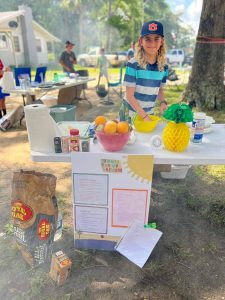 Did you get to do any grilling this summer? Many of our 4-Hers did! Over 100 youth from throughout the Florida panhandle participated in 4-H summer day camps that taught them food and fire safety, safe grilling, and proper cooking skills.
Did you get to do any grilling this summer? Many of our 4-Hers did! Over 100 youth from throughout the Florida panhandle participated in 4-H summer day camps that taught them food and fire safety, safe grilling, and proper cooking skills.
Day camps offered unique experiences to youth on grilling techniques all summer and helped youth prepare for our District Competition. On July 30, 2022, 28 youth from eight counties participated in the Northwest District Tailgating Contest at the Washington County Ag Center in Chipley, Florida. Youth participated in competitions in beef, pork, chicken, and shrimp divisions and were judged on their food and fire safety skills around the grill and the taste of their chosen protein. In all, $3,200 was awarded to panhandle youth for placing 1st-4th in their competitions.
Now the top two youth in each protein category will compete at the Florida 4-H Tailgating Contest in Gainesville on October 1, 2022. They will compete against youth from across Florida for an opportunity to win college scholarships. For the state contest, the first-place winner in each protein area receives a $1,500 college scholarship and the second-place winner receives a $1,000 college scholarship.
Join us as we cheer on the following NW District 4-H participants as they represent us at the Florida 4-H State Tailgating Contest:
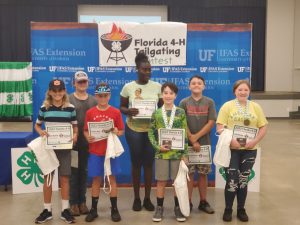
2022 Seafood Category Winners
-
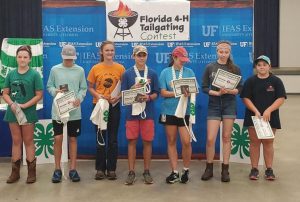
2022 Beef Category Winners
Beef Division
- Aubrie D.-Escambia County
- Aidden Y.-Walton County
- Pork Division
- Brooke H.-Escambia County
- Cate B.-Okaloosa County
- Chicken Division
- Vanessa E.-Wakulla County
- Jamison S.-Jackson County
- Shrimp Division
- Addie M.-Escambia County

2022 Pork Category Winners
- Mason K.-Escambia County
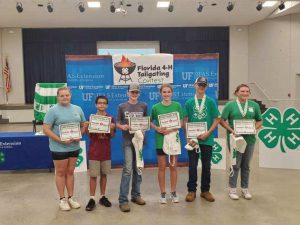
2022 Chicken Category Winners
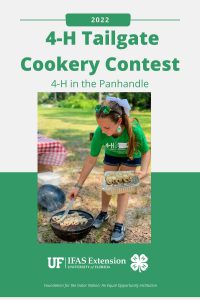 If you are interested in furthering your grilling skills, please check out the Florida 4-H Tailgate Series of EDIS documents. If you would like more information on the Tailgating Contest to prepare for next year, check out our brand new handbook! Finally, the top two winners in each protein category are sharing their award-winning recipes in this free, downloadable eBook!
If you are interested in furthering your grilling skills, please check out the Florida 4-H Tailgate Series of EDIS documents. If you would like more information on the Tailgating Contest to prepare for next year, check out our brand new handbook! Finally, the top two winners in each protein category are sharing their award-winning recipes in this free, downloadable eBook!
by pmdavis | Jul 1, 2022
It’s hard to believe the 4th of July is already upon us!
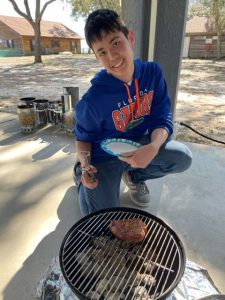
Youth learning to grill during 4-H tailgate program
Many of us will be celebrating with picnics, cookouts, and family get-togethers. One of my colleagues in Clay County, Samantha Murray, did a great article about preventing food poisoning while celebrating. Our youth have also been attending grilling summer camp programs and learning many of these tips plus lots more. The youth have learned about how to use a grill safely, how to prepare food safely and prevent cross-contamination or food-borne illness, and the nutritional benefits of animal protein in diets. Our district will have its annual competition to advance to the state-level competition on July 30 at the Washington County Extension Office, in Chipley, Florida.
I just wanted to take a moment to recap the tips Samantha gave to keep all of us safe and healthy while celebrating.
- Keep raw meats in a separate cooler than ready-to-eat items or beverages.
- Foods with mayonnaise are less acidic creating a better environment for bacterial growth
- Chicken and ground beef needs to be cooked to 165°F
- Wash hands if soap and water are not available use hand sanitizer to reduce the risk of contaminating food.
- Use different tongs or spatulas for cooked and uncooked meat or wash them after being in contact with raw meat.
- It is recommended to refrigerate leftovers within two hours unless it’s really hot, then the window shrinks to about an hour.
Other items you may want to think about.
- Keep beverages in a separate cooler from other foods, people will be going in and out of beverage coolers much more keeping the temperature higher and allowing bacterial growth.
- Cook cuts of pork, beef, or shrimp to 145°F
- Don’t sit charcoal grills on plastic tables and make sure the area is free from debris that can catch fire, including limbs or tents overhead.
- Clean up after yourself leaving only footprints in the area you were in!
- Enjoy time with friends and family safely!
For more information about educational programs, check out our webpage or contact your local UF IFAS Extension Office.
by Rachel Pienta | Jan 21, 2022
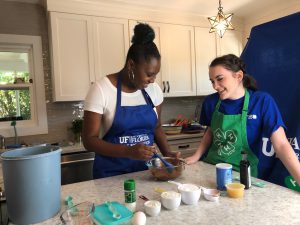 Healthy Living is one of the 4-H’s. While your club may not specifically focus on what is traditionally considered to be “healthy living” activities, you might be surprised about much your 4-H club is contributing to the mental and physical well-being of youth members. After we recognize that all our clubs have a role to play in implementing healthy living strategies across the county 4-H program, we can start to consider ways to be intentional in how we incorporate healthy living into 4-H activities and projects.
Healthy Living is one of the 4-H’s. While your club may not specifically focus on what is traditionally considered to be “healthy living” activities, you might be surprised about much your 4-H club is contributing to the mental and physical well-being of youth members. After we recognize that all our clubs have a role to play in implementing healthy living strategies across the county 4-H program, we can start to consider ways to be intentional in how we incorporate healthy living into 4-H activities and projects.
What does a 4-H Healthy Living program include? A 4 H Healthy Living program or strategy is any activity or program component that can help youth lead lives that balance physical, mental, and emotional health.
According to the National 4-H Council, 4-H Healthy Living programs include objectives that can help “empower youth to be healthy – body and mind – with the skills to make healthy decisions and lead healthy lifestyles. Having the confidence and skills to lead healthy lifestyles not only improves overall well-being; it enables youth to tackle life’s challenges today and become leaders in their lives, careers, and communities as they grow into responsible adulthood” (National 4-H Council, 2021). Your club focus might fit into one of the following program areas: mind, body, leadership, or mentorship.
As a club leader, you may encourage your youth to adopt goals and projects that will cover multiple program areas. Introducing healthy living during club meetings is another way to incorporate these concepts and help youth develop healthier habits.
With so many possible topics to consider, it may seem overwhelming to choose a starting point. In this article, a few suggestions will be explored.
Sleep
It may be surprising to learn that youth, like adults, are not getting enough sleep. Regularly missing hours of sleep or experiencing poor sleep quality can contribute to a variety of issues for youth. The Sleep Foundation is one resource to use for tips on how to encourage our 4-H members to adopt better sleep habits (Pacheco, 2021).
Some ideas for helping your 4-H youth learn about the importance of sleep and how to develop better sleep habits include the activities and lessons listed in the links below this paragraph. Consider challenging your youth to set healthy sleep goals for one month. Discuss the potential benefits during your goal setting activity. At the end of the month, discuss how youth felt on days when the sleep goals were met and how they felt on days when they did not meet their goal.
Activity for Teens (Intermediates and Seniors)
University of Wisconsin Extension. 2007. “4-H Get Fit, That’s It. Lesson 2: Are You Getting Enough Sleep.” Link to activity: https://api.ag.purdue.edu/api/DepotWS/File.ashx?t=f&i=98730
Activity for Elementary School Age (Juniors 4-H Members)
The Nemours Foundation. 2015. Sleep. Kids’ Health in the Classroom.
https://classroom.kidshealth.org/classroom/3to5/body/functions/sleep.pdf
Hydration
One way to incorporate a healthy living strategy into your 4-H program is offering water at all your meetings and limiting the inclusion of other beverages. A 4-H lesson on hydration can include STEM principles as youth can calculate their daily water needs based on their body weight. A fun way to encourage water consumption is to personalize reusable water bottles as a club activity and to award points to youth who remember to bring their bottles to meetings and activities.
All Ages Lesson and Activity
National 4-H Council.2020. How Much Water Do You Need? 4-H Healthy Living Activity Guide.
https://4-h.org/wp-content/uploads/2019/04/4H-Healthy-Living-Activity-Guide.pdf
Other Ways to Incorporate Healthy Living into Your Club Programs
Activities designed to improve sleep and hydration are only two of many possible ways to incorporate healthy living into your 4-H program. Healthy Living activities can incorporate exercise, nutrition, and ways to improve and maintain mental health.
Resources
Caruso, L.; Shelnut, K.; Kauwell, G. 2017. Hydration Myths. UF/IFAS Extension. Retrieved January 16, 2022 from https://edis.ifas.ufl.edu/publication/FY1409.
National 4-H Council. 2021. Healthy Living. Retrieved January 16, 2022 from https://4-h.org/parents/healthy-living/.
Pacheco, D. 2021. Children and Sleep. The National Sleep Foundation. Retrieved January 16, 2022 from https://www.sleepfoundation.org/children-and-sleep.
University of California 4-H Youth Development Program. 2022. Sleep for Better Living. Retrieved January 16, 2022 from https://4h.ucanr.edu/Projects/HealthyLiving/Sleep_for_Better_Living/
by Marie Arick | Sep 27, 2021

Marie Arick
Greetings, my name is Marie Arick and I am the County Extension Director, 4-H and Family & Consumer Sciences Agent in Liberty County. Beginning in 2019, I stepped into this complex, but rewarding position and have worked with volunteers, community partners and other Agents on some amazing projects.
The 4-H program provides a diverse array of opportunities for youth ages 8 to 18. One great example is the Liberty County Livestock Club. This club provides a variety of animal projects and agricultural judging opportunities. As an Agent, I support my volunteers with curriculum, training opportunities and fund raising. This club successfully fund-raised enough money to buy a set of portable livestock scales to aid with animal projects.
School enrichment is a large part of 4-H programming for Liberty County youth. The two most successful are the Ag Adventures and the Embryology in the Classroom programs. Ag Adventures introduces youth to many crops and their uses. While teaching cotton in the field during this program, it surprised me how many youths did not know that our ‘paper’ money contains cotton. With embryology, each year is met with excitement when we enter the classroom with the incubators and eggs. The daily lessons include learning the parts of the egg and following the growth of the chick. Egg candling sessions allow me the opportunity to see how much the kids have learned and there is no shortage of enthusiasm when the chicks hatch. While Covid-19 did inhibit Ag Adventures for 2020, it did not stop Embryology. All incubators and supporting equipment along with the eggs were delivered to the schools. Lesson videos were created and other supporting materials were all placed on a closed Google site for the teachers to utilize.

Embryology Google Site
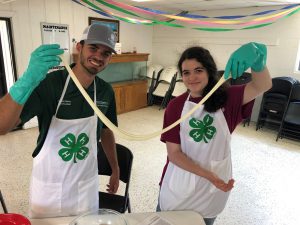
4-H University Cheese Making
As an Agent, one experience that never gets old is to ask a group of 4-H youth if they think they can transform a gallon of milk, using a few additional ingredients and a recipe, into mozzarella cheese. I absolutely love watching the skeptics successfully participate in the workshop and create their mozzarella cheese. In the process, these youth learn about food safety, kitchen safety, recipe literacy and adherence. The ‘learn by doing’ motto drives this experience.
Prior to adding 4-H to my Extension Agent assignment, I still incorporated youth into my Jackson County Family & Consumer Sciences programming, specifically culinary arts. Cooking is a life skill, we all eat! What better way to introduce food safety, kitchen safety, nutrition, and a variety of food preparation methods to youth than through culinary arts. Once I transitioned into a 4-H role, I added cheese making, grilling, food challenge, food preservation and more. Kids are more likely to try a new food, or an old favorite prepared in a healthier manner, if they make it themselves.
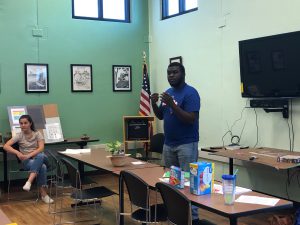
Carlos Staley, UF Intern
The above programs have shown great success, but 4-H offers a broad range of programs and there is something for everyone. My reward is each child’s success. It is even more gratifying when a former high school student that participated in the culinary arts school enrichment program for two years is now attending UF studying food science. The icing on the cake, so to speak, is when he becomes your UF summer intern!
I am a Mississippi State University graduate with a BS in Exercise Science and a MS in Health Promotion. After a long stint in the medical field, I transitioned to my second career choosing Extension. I began working with Texas A & M AgriLife Extension prior to transitioning to the University of Florida IFAS Extension in 2015. Extension is extremely rewarding, but in my down time I enjoy kayaking, gardening, and reading.
by Claire Davis | Jul 5, 2021
 Summer is upon us and so is the heat in the Florida Panhandle. Schools are out and the kids are at home needing activities to do together. Homemade Freezer Pops are an excellent source of fun! These popsicles can be secretly healthy and taste absolutely delicious. They don’t have to just be for the kids either, adults of all shapes and sizes can enjoy them too. In this article we will discuss what freezer pops are, how to make them, and a few tips for maximum enjoyment!
Summer is upon us and so is the heat in the Florida Panhandle. Schools are out and the kids are at home needing activities to do together. Homemade Freezer Pops are an excellent source of fun! These popsicles can be secretly healthy and taste absolutely delicious. They don’t have to just be for the kids either, adults of all shapes and sizes can enjoy them too. In this article we will discuss what freezer pops are, how to make them, and a few tips for maximum enjoyment!
What are Freezer Pops?
A freezer pop is a frozen treat that generally comes in a clear, plastic tube. Freezer pops, not to be confused with popsicles which are typically consumed off a wooden popsicle stick, are found in grocery stores in unfrozen liquid form, ready for the consumer to pop them into their freezer at home! Once frozen solid, the consumer picks their flavor of choice, cuts open an end of the plastic tube, and simply squeezes or pushes the sweet ice out of the packaging.
Many of us know these sweet and fruity slushy pops as Otter Pops or Fla-Vor-Ice. These nostalgic treats are simply made from sweetened, colored, and flavored water. With little nutritional value coming from the store-bought version, homemade freezer pops can be much more nutritious. Keep following along to find out how to make these tasty treats!
How to make Homemade Freezer Pops
Freezer pops are super easy to make and are a healthier alternative to the nostalgic treat. Before you get started, you will need all the necessary supplies. Supplies commonly found at home would include a freezer and a blender. Supplies that can be bought at the store are Zipzicles (a freezer pop reusable plastic bag) or silicone ice pop molds, fruit of your choice, and a natural sweetener like honey.
Step 1: Wash your hands! Handwashing is one of the best ways to protect yourself and others from spreading germs. You should wash hands before, during, and after preparing your food. To wash your hands the right way, first wet your hands with warm, clean, running water. Then turn off the tap and apply your soap. Lather your hands (make lots of white foams/bubbles) by rubbing them together with the soap. Make sure you lather the back of your hands, between your fingers, under your nails, and palm of your hands. Scrub for about twenty seconds. (Don’t know how long 20 seconds is? Hum the “Happy Birthday” song from the beginning to the end twice!) Finally, rinse your hands well under warm, clean, running water and either dry with a clean towel or air dry. (1)
preparing your food. To wash your hands the right way, first wet your hands with warm, clean, running water. Then turn off the tap and apply your soap. Lather your hands (make lots of white foams/bubbles) by rubbing them together with the soap. Make sure you lather the back of your hands, between your fingers, under your nails, and palm of your hands. Scrub for about twenty seconds. (Don’t know how long 20 seconds is? Hum the “Happy Birthday” song from the beginning to the end twice!) Finally, rinse your hands well under warm, clean, running water and either dry with a clean towel or air dry. (1)
Step 2: Gather your ingredients to be blended. There are lots of fruits that make great homemade ice pops: watermelon, orange, pineapple, mango, raspberry, honeydew, cantaloupe, and strawberry! (3)
One of my favorite recipes for freezer pops uses 10 ounces of ripe berries, ~½ a cup of water, and 1-2 tablespoons of honey. If the fruit you use is very juicy, you may not have to use as much water but remember, the more water that you use, the icier the pop will become in the freezer. You can also use either lemon or lime juice to add a little flavor boost!. (3) The amount of sweetener needed varies as the sugar content of the berries can vary. If the berries are ripe and sweet, use a little less sweetener. If the berries are not as ripe, simply use a little more sweetener. Then blend all the ingredients together completely, until smooth!
Step 3: Fill individual baggies of your choosing. Make sure to not over fill the bags.
Step 4: Freeze the freezer pops for ~ 2 to 4 hours before enjoying. If you consume them around 2 hours, they may not be as solid as they will be at the 4-hour mark.
Step 5: Enjoy a refreshing treat!
Tips for Homemade Freezer Pops
- The sweetness of the chosen fruit will be muted once frozen. Make sure to use over ripe fruit or added sweetener to keep the treat sweet.
- Use a funnel to fill your freezer pop bags. Using a funnel will keep you from making too much of a mess, and will also help you mind the “maximum fill line” on the bag. If you keep the contents you are pouring into the bag under the line, it will be easier to seal! \
- Just about anything that can be blended or pureed can be used for a freezer pop! Leftover smoothies, various fruit juices, and even sodas make for easy treats! Check out the image below to see flavors others have created! (4)
For National Freezer Pop Day, July 8th, 2021, enjoy making homemade freezer pops with your family! With a snip of the scissors, you’ll produce smiles with every sip. (2)
 With the holiday season fast approaching, everyone’s favorite dishes will soon appear on the dinner table. Everyone has different taste buds, so that means everyone has different favorite dishes. I know that I am looking forward to sweet potato soufflé and deviled eggs, but I could definitely do without the cranberry sauce. Unfortunately, many parents find themselves in a bind trying to feed their picky eaters. Remember, you are not alone in this battle, and try not to get too frustrated by this typical behavior. This article includes some tips on what to avoid and strategies to help your favorite picky eater!
With the holiday season fast approaching, everyone’s favorite dishes will soon appear on the dinner table. Everyone has different taste buds, so that means everyone has different favorite dishes. I know that I am looking forward to sweet potato soufflé and deviled eggs, but I could definitely do without the cranberry sauce. Unfortunately, many parents find themselves in a bind trying to feed their picky eaters. Remember, you are not alone in this battle, and try not to get too frustrated by this typical behavior. This article includes some tips on what to avoid and strategies to help your favorite picky eater!













